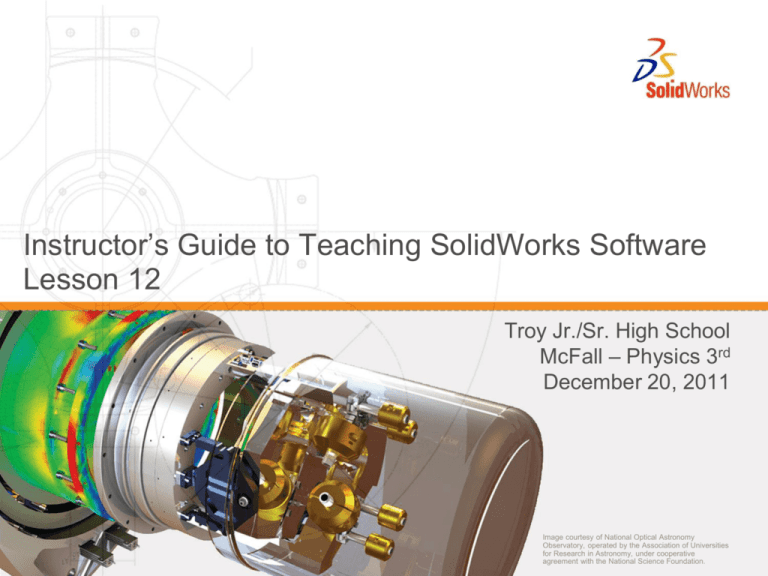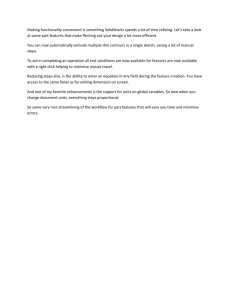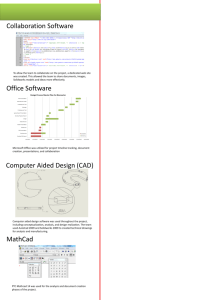File - Mr. McFall's Science Emporium
advertisement

Instructor’s Guide to Teaching SolidWorks Software Lesson 12 Troy Jr./Sr. High School McFall – Physics 3rd December 20, 2011 Image courtesy of National Optical Astronomy Observatory, operated by the Association of Universities for Research in Astronomy, under cooperative agreement with the National Science Foundation. What is SolidWorks SimulationXpress? SolidWorks SimulationXpress is a design analysis software that is fully integrated in SolidWorks. SolidWorks SimulationXpress simulates the testing of your part’s prototype in its working environment. It can help you answer questions like: how safe, efficient, and economical is your design? SolidWorks SimulationXpress is used by students, designers, analysts, engineers, and other professionals to produce safe, efficient, and economical designs. 2 Traditional Design Cycle Use SolidWorks to build the model. Manufacture a prototype. Test the prototype under various loading conditions. Instrumentation is needed in most cases. Based on results, modify the model in SolidWorks, build a new prototype, and test it again until you are satisfied. SolidWorks Prototype Test Satisfied? No Yes Mass Production 3 Benefits of Analysis Design cycles are expensive and time-consuming. Analysis reduces the number of design cycles. Analysis reduces cost by testing your model using the computer instead of expensive field tests. Analysis reduces time to market. Analysis can help you optimize your designs by quickly simulating many concepts and scenarios before making a final decision. 4 The Finite Element Method Analytical solutions are only available for simple problems. They make many assumptions and fail to solve most practical problems. SolidWorks SimulationXpress uses the Finite Element Method (FEM). Analysis using the FEM is called Finite Element Analysis (FEA) or Design Analysis. FEA is very general. It can be used to solve simple and complex problems. FEA is well-suited for computer implementation. It is universally recognized as the preferred method of analysis. 5 Main Concept of Design Analysis The FEM replaces a complex problem by many simple problems. It subdivides the model into many small pieces of simple shapes called elements. CAD Model CAD Model Subdivided into Small Pieces 6 Main Concept of Design Analysis The elements share common points called nodes. The behavior of these elements is well-known under all possible support and load scenarios. Nodes The motion of each node is fully described by translations in the X, Y, and Z directions. These are Tetrahedral Element called degrees of freedom (DOF). Each node has 3 DOF. 7 Main Concept of Design Analysis SolidWorks SimulationXpress writes the equations governing the behavior of each element taking into consideration its connectivity to other elements. These equations relate the unknowns, for example displacements in stress analysis, to known material properties, restraints and loads. Next, the program assembles the equations into a large set of simultaneous algebraic equations. There could be hundreds of thousands or even millions of these equations. 8 Main Concept of Design Analysis In static analysis, the solver finds the displacements in the X, Y, and Z directions at each node. Now that the displacements are known at every node of each element, the program calculates the strains in various directions. Strain is the change in length divided by the original length. Finally, the program uses mathematical expressions to calculate stresses from the strains. L L Strain = L)/L 9 Static or Stress Analysis This is the most common type of analysis. It assumes linear material behavior and neglects inertia forces. The body returns to its original position when loads are removed. It calculates displacements, strains, stresses, and reaction forces. A material fails when the stress reaches a certain level. Different materials fail at different stress levels. With static analysis, we can test the failure of many materials. 10 What is Stress? When a load is applied to a body, the body tries to absorb the effect by generating internal forces that vary from one point to another. F P A The intensity of these forces is called stress. Stress is force per unit area. Stress at a point is the intensity of force on a small area around that point. P lim F/A A 11 What is Stress? Stress is a tensor quantity described by magnitude and direction in reference to a certain plane. Stress is fully described by six components: – – – – SX: Normal stress in the X-direction SY: Normal stress in the Y-direction SZ: Normal stress in the Z-direction TXY: Shear stress in the Y-direction on YZ-plane – TXZ: Shear stress in the Z-direction on YZ-plane – TYZ: Shear stress in the Z-direction on XZ-plane Positive stress indicates tension and negative stress indicates compression. 12 Principal Stresses Shear stresses vanish for some orientations. Normal stresses at these orientations are called principal stresses. Z 3 – P3: Normal stress in the third principal direction (smallest). P2 2 – P1: Normal stress in the first principal direction (largest). – P2: Normal stress in the second principal direction (intermediate). P3 Y o X 1 P1 Axes 1,2, and 3 are called principal directions and the normal stresses P1, P2, and P3 are called principal stresses. 13 von Mises Stress von Mises stress is a positive scalar number that has no direction. It describes the stress state by one number. Many materials fail when the von Mises stress exceeds a certain level. In terms of normal and shear stresses, von Mises stress is given by: 1 VON = --- SX – SY 2 + SX – SZ 2 + SY – SZ 2 + 3 TXY 2 + TXZ2 + TYZ2 2 1 2 In terms of principal stresses, von Mises stress is given by: 1 2 2 2 VON = --- P1 – P2 + P1 – P3 + P2 – P3 2 1 2 14 Analysis Steps 1. Assign materials. What is the part made of? 2. Specify restraints. Which faces are fixed and do not move? 3. Apply loads. Where are the forces or pressures acting on the part? 4. Run the analysis. 5. View the results. What is the factor of safety? What are the resultant displacements or stresses? 15 Additional Analysis Types SolidWorks SimulationXpress performs linear, static stress analysis on parts. Other software tools provide additional means of analyzing parts and assemblies. SolidWorks Simulation includes: – – – – – – – – – Linear, static stress analysis on assemblies. Non-linear static analysis Buckling analysis Frequency analysis Thermal and Thermal stress analysis Optimization analysis Dynamic analysis Fatigue analysis Drop test analysis 16 Additional Analysis Types SolidWorks Flow Simulation includes: – Flow simulation of liquids and gases over and inside 3D objects SolidWorks Motion Simulation includes: – Dynamic and kinematic simulation 17




